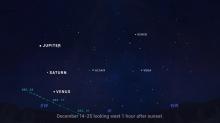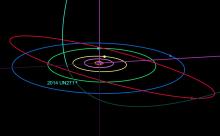Listen to today's episode of StarDate on the web the same day it airs in high-quality streaming audio without any extra ads or announcements. Choose a $8 one-month pass, or listen every day for a year for just $30.
You are here
Distant Comet
The most-often-observed of all comets should be ready to head back our way. Calculations of its orbit say it should be farthest from the Sun today — more than three billion miles away. That means it’ll start its plunge back toward the Sun. It’ll take a while to get here, though — it won’t get closest to the Sun until 2061.
The first confirmed sighting of Halley’s Comet came in 240 B.C. The comet is a ball of ice and rock a few miles across. When it approaches the Sun, it sprouts a long, bright tail.
Halley orbits the Sun once every 74 to 79 years. It’s easily pushed around by the gravity of Jupiter and Saturn, so no two orbits are the same.
Halley was the first comet that was known to periodically return to view. British astronomer Edmond Halley used Isaac Newton’s laws of gravity to compare the appearances of several comets over the centuries. He discovered that they were repeat appearances of the same comet. Halley calculated that it would return to view in 1758. When it did, the comet was named in his honor.
Comet Halley was last visible in Earth’s night sky in 1986. It was a so-so appearance. But some of its visits have been spectacular. In 1910, it caused widespread fear when astronomers reported that Earth would pass through its tail. People bought bogus “comet pills” to protect themselves from its influence. But there was no danger at all — only a beautiful display in the night sky.
Script by Damond Benningfield






